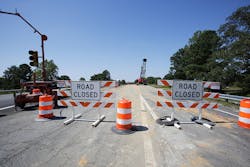This week the U.S. Chamber of Commerce released a four-part plan entitled Roadmap to Rebuilding America’s Infrastructure that seeks, among other things, to implement a 25-cent hike in federal fuel taxes over a five year period in order to generate nearly $400 billion worth of funds over the next decade to expand, repair and reinvigorate the U.S. transportation system.
That call for a fuel tax increase mirrors similar proposals made by the American Trucking Associations (ATA) both in December and in May last year. It’s also been argued by the American Transportation Research Institute (ATRI) that fuel taxes are the best way to fund infrastructure programs.
“After decades of inaction, now is the time Washington should move on rebuilding and modernizing America’s infrastructure,” noted Tom Donahue, president and CEO of the U.S. Chamber, during a gathering billed as America’s Infrastructure Summit this week.
[Donahue also served as ATA’s chief executive for 13 years before joining the U.S. Chamber in 1997; making transportation issues familiar territory for him.]
“It’s time to approach this as a national imperative for long-term growth and competitiveness — not an exercise in parochial politics,” he added. “Increasing the [fuel tax] fee by a total of 25 cents – indexed for inflation and improving [vehicle] fuel economy – would raise $394 billion over the next 10 years.”
Donahue noted that the monetary value of fuel taxes, last raised in 1993, are being eaten away by inflation and improvements in vehicle fuel economy have eroded its value.
As a result, the federal highway and transit trust fund faces a shortfall of $138 billion over the next decade, he said – which is why the U.S. Chamber is proposing a five-cent increase in fuel taxes over five years that will add up to a 25-cent hike.
From a cost-benefit perspective, that tax increase “would cost the average motorist about $9 a month, but our badly deteriorating roads are causing approximately $40 a month in increased maintenance and operating costs” to them, Donahue explained.
Will the general public buy this argument? More importantly, will Congress buy it? In the recent past, polls have shown that folks are concerned about the decrepit state of U.S. roads and bridges, but paying for their repair, expansion and upkeep remains a tough sell.
Congressional legislators have been reluctant for years to raise fuel taxes or add other types of fees to provide more funds for transportation infrastructure needs – to the point where state and local governments started adding them on their own in recent years.
Turning back to the U.S. Chamber’s transportation infrastructure roadmap, there are three other key initiatives being proposed:
Expand financing options, like public/private partnerships, for local communities: Besides fixing crumbling roads and bridges, the U.S. Chamber stressed that airports, seaports, waterways, electrical grids, Internet broadband networks, and other infrastructure projects need funding, too – and to handle all of that successfully will require more involvement from the private sector.
“When it comes to private funding, there is huge potential. Between 2005 and 2015, infrastructure equity bonds raised about $350 billion,” Donahue noted. “Since equity is about 25% of a typical public-private partnership, that $350 billion could support projects worth $1.4 trillion.”
The Chamber thus suggests federal loan programs should be broadened to facilitate public-private partnerships. Also state and local governments should leverage public dollars with federally-backed loans.
“Innovative financing mechanisms will allow us to meet today’s infrastructure needs and build for the future while financing the costs over the long-term,” Donahue said.
Streamline the permitting process to get projects off the ground: Finding the money to fund infrastructure needs is “only half the battle,” as the lengthy permitting process required to build roads, bridges, etc., creates significant time delays and raises project costs. “Without permitting reform, all the funding the financing you could dream of won’t get the job done,” Donohue explained. “Projects become seriously delayed or even canceled and their budgets skyrocket due to an uncertain and seemingly endless permitting process.”
Instead of long, drawn-out permitting delays, the Chamber proposes that all federal infrastructure approvals should be completed within two years, with state and local projects that get federal funding or financing also adhering to that two-year timeline. To further the streamlining process, a single “lead agency” should shepherd any infrastructure project through the process from start to finish.
A skilled workforce to build such projects is needed:
Even if the funding is in place, and the approval process is smooth and certain, infrastructure projects won’t be built if there aren’t skilled workers available to do it – and there’s a shortage of construction workers, just as there is a shortage of truck drivers.
“Nearly 80% of construction firms report that they are having a hard time finding qualified workers,” Donahue noted. “At the same time, by some estimates, every $1 million in additional infrastructure spending requires the addition of six to seven construction jobs. Who is going to fill those positions?” The U.S. Chamber’s solution mirrors one being bandied about for truck drivers: apprenticeship programs that will allow workers to learn on the job.
“Infrastructure has been an issue neglected for too long. But 2018 can be the year that changes,” Donahue stressed. “This is the next great opportunity to do something significant, something long-lasting, and something long-overdue, for our nation’s future. And it will benefit all of us.”
Now the trick will be to see if there’s enough political will to back up that vision.
About the Author
Sean Kilcarr
Editor in Chief
Sean Kilcarr is a former longtime FleetOwner senior editor who wrote for the publication from 2000 to 2018. He served as editor-in-chief from 2017 to 2018.
